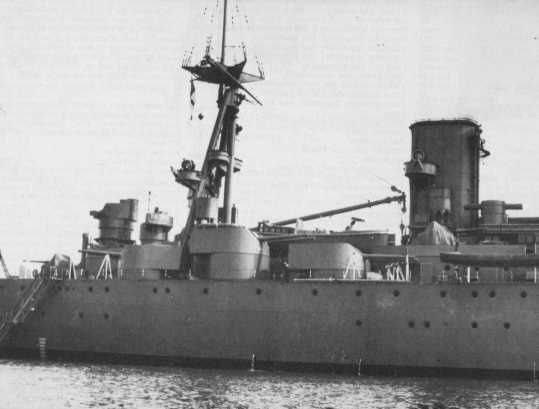
A more powerful weapon than the previous 6" (15.2 cm) Mark XII, this gun was originally designed for the never-built "G3" battlecruisers. When those ships were canceled as a result of the Washington Naval Limitation Treaty, the guns and mountings were then used on the Nelson class battleships. These were the first British battleships to carry their secondary armament in turrets rather than in broadside casemates.
Like many British medium-caliber mountings of the 1920s, these guns had a high maximum elevation so that they could engage aircraft, but this was of secondary importance to their use in the anti-ship role. In reality, the training and elevation speeds of the mountings were too slow for the AA role.
The arrangement on the Nelson class had a major disadvantage in that all turrets and their working spaces were grouped tightly together. As the turrets and working spaces were only lightly protected by 1" (25 mm) HT plating, this meant that a single shell could have disabled all guns on one side.
The Mark XXII* was constructed of A tube, taper wound wire, full-length jacket, breech ring and breech bush screwed into the A tube. Used a hand-operated Welin breech block. When this gun was relined with a tapered inner A tube having three locating shoulders, it became the Mark XXII. The later Mark XXII** was built without wire and used an inner A tube. A total of 40 guns were built, including two experimental guns and six Mark XXII**.
| Designation | 6"/50 (15.2 cm) BL Mark XXII |
|---|---|
| Ship Class Used On | Nelson Class |
| Date Of Design | about 1921 |
| Date In Service | 1926 |
| Gun Weight | Mark XXII and Mark XXII*
Without Breech: 19,824 lbs. (8,992 kg) Weight of Breech: 364 lbs. (165.1 kg) Mark XXII**
|
| Gun Length oa | 309.7 in (7.866 m) |
| Bore Length | 300 in (7.620 m) |
| Rifling Length | 255.6 in (6.491 m) |
| Grooves | (36) 0.046 in deep x 0.3759 (1.17 x 9.548 mm) |
| Lands | 0.1477 in (3.752 mm) |
| Twist | Uniform RH 1 in 30 |
| Chamber Volume | 1,750 in3 (28.7 dm3) |
| Rate Of Fire | 5 rounds per minute 1 |
- ^The original design requirement was for a rate of fire of 7 to 8 rounds per minute. On trials, the best rate achieved was 4 rounds per minute. Some modifications were carried out afterwards, and these improved the rate of fire. During her battle with Bismarck, Rodney fired 150 salvos (one gun from each turret) from her starboard battery at an average of 5 salvos per minute and 98 salvos from her port battery at an average of 3.9 salvos per minute. During the first 9 minutes at close range she achieved 5.9 rounds per minute and an output of nearly 100%. In all, Rodney fired 716 rounds of 6" (15.2 cm) CPBC during this action.
| Type | Bag |
|---|---|
| Projectile Types and Weights 1a | CPBC Mark XXVB: 100 lbs. (45.36 kg)
CPBC (1942): 112 lbs. (50.8 kg) HE: N/A |
| Bursting Charge | N/A |
| Projectile Length | N/A |
| Propellant Charge | 31 lbs. (14.1 kg) SC 150 2a |
| Muzzle Velocity | 2,945 fps (898 mps) |
| Working Pressure | 20 tons/in2 (3,150 kg/cm2) |
| Approximate Barrel Life | 600 rounds |
| Ammunition stowage per gun | Normal: 100 rounds 3a Maximum: 150 rounds 3a 4a |
- ^As of 1942, the same projectiles as used for the Mark XXIII were issued for these guns. See that datapage for details.
- ^The propellant was in a single bag. Flashless does not seem to have been issued.
- ^Maximum ammunition stowage consisted of 135 CPBC, 15 HE and 24 practice rounds per gun.
| Elevation | Muzzle Velocity | Distance | Flight Time |
|---|---|---|---|
| 2.1 degrees | 2,900 fps (884 mps) | 5,000 yards (4,570 m) | 6.2 seconds |
| 5.6 degrees | 10,000 yards (9,140 m) | 15.2 seconds | |
| 12.1 degrees | 15,000 yards (13,720 m) | 28.6 seconds | |
| 22.9 degrees | 20,000 yards (18,290 m) | 46.1 seconds | |
| 42.6 degrees | 25,000 yards (22,860 m) | 74.9 seconds | |
| 45.0 degrees | N/A | 25,800 yards (23,590 m) | N/A |
| Designation | Twin Mounts
Nelson (6): Mark XVIII 1b |
|---|---|
| Weight | 168,000 lbs. (76,204 kg) |
| Elevation | -5 / +60 degrees |
| Elevation Rate | 8 degrees per second 3b |
| Train | Forward Mountings: +75 / -75 degrees
Center (superfiring) Mountings: +90 / -90 degrees After Mountings: +72.5 / -72.5 degrees |
| Train Rate | about 5 degrees per second 3b |
| Gun recoil | 16.5 in (42 cm) |
| Loading Angle | +5 degrees |
- ^These mountings had very thorough flash precautions, which may have contributed to the slower ROF. However, the use of turrets rather than casemate mounts meant that much of the ammunition supply could be automated, thus reducing crew fatigue. The turrets had better arcs of fire both in both the horizontal and vertical planes and as they were mounted on the weather deck, this also meant that they were drier and could function even in heavy seas that would wash out the broadside mounts of earlier designs.
- The ammunition supply for these mountings was somewhat clumsy. There was a lower magazine with one handling room. Two hoists supplied the working spaces of P1 and S1 turrets (the forward turrets on each side), while an upper magazine with two handling rooms and four hoists supplied the working spaces of the other four turrets. The shell room was above the lower magazine and was equipped with six hoists. The lower charge hoists were endless chain types while the shell hoists were of a pusher type, all of which were electrically powered. The upper hoists to the turrets were hydraulically powered. There was one charge and one shell hoist per gun and these revolved with the turret. Charges were stored in Clarkson's cases and went up the hoists in them and were not removed until just before loading into the guns. The cases were returned to the working spaces via a tube and then to the magazines by the down side of the lower hoists and through flashtight scuttles into the magazines.
- The following comments are from the report by Capt. Thomas Hugh Binney (RN) to the Admiralty upon finishing his tour of command of HMS Nelson in 1930:
In the case of the secondary armament, although the rate of fire is rather low, the increased range at which fire can be opened, and the absence of loss of output due to fatigue, combined with excellent ammunition supply arrangements, will be a very pronounced factor in war.
In view of the modern tendency of construction for 'all or nothing' armour protection leaving controls and secondary batteries unprotected, the possibility for using the secondary battery for 'harassing fire' at the main armoured target when the range has been found assumes greater importance, and in Nelson the secondary armament can do this efficiently without loss of anti-torpedo boat efficiency.
- Armor protection was D quality steel. Thickness as given in "British Naval Gun Mountings":
Face: 1.47 in (3.7 cm) (60 lbs.)
Sides, Rear and Roof: 0.98 in (2.5 cm) (40 lbs.)
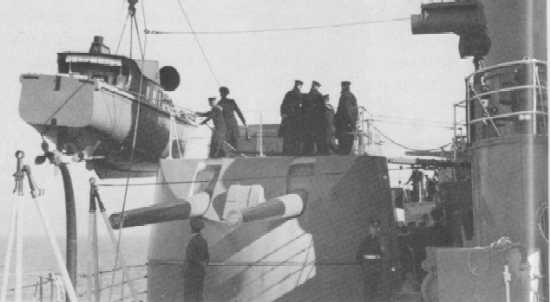
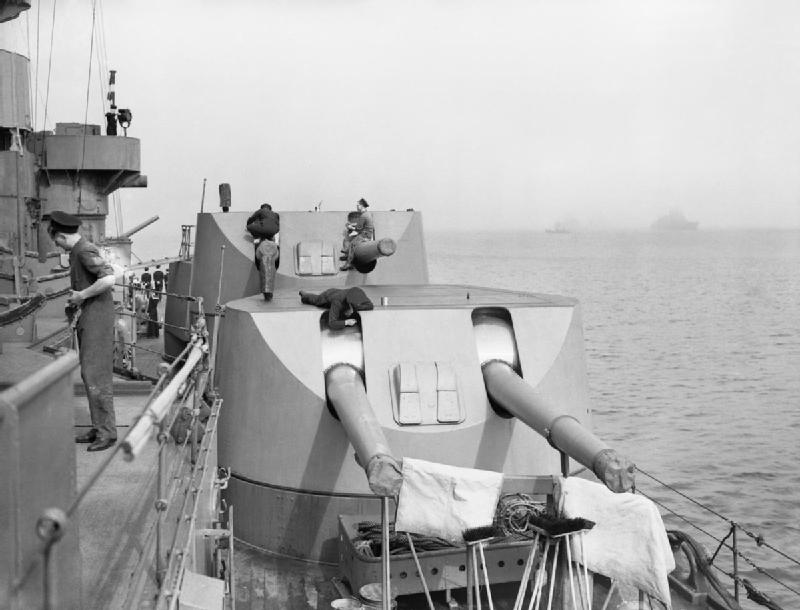
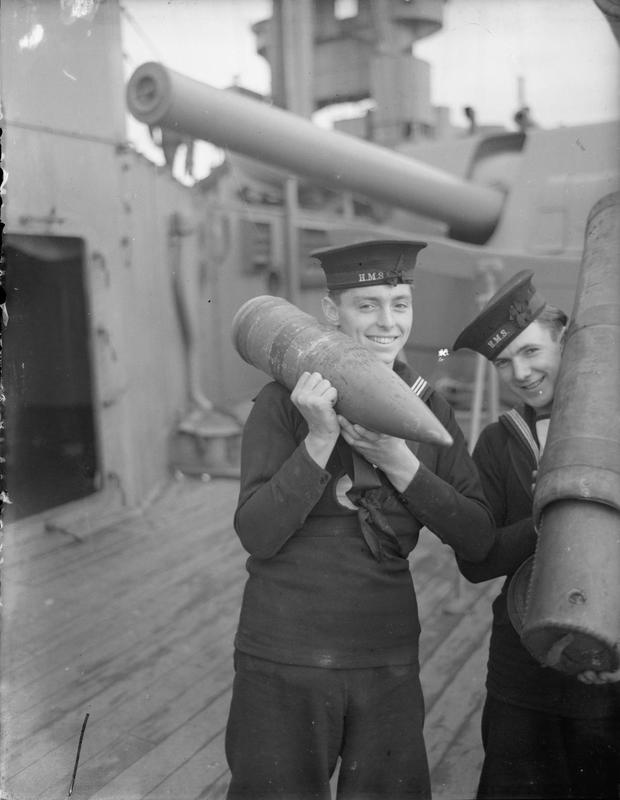
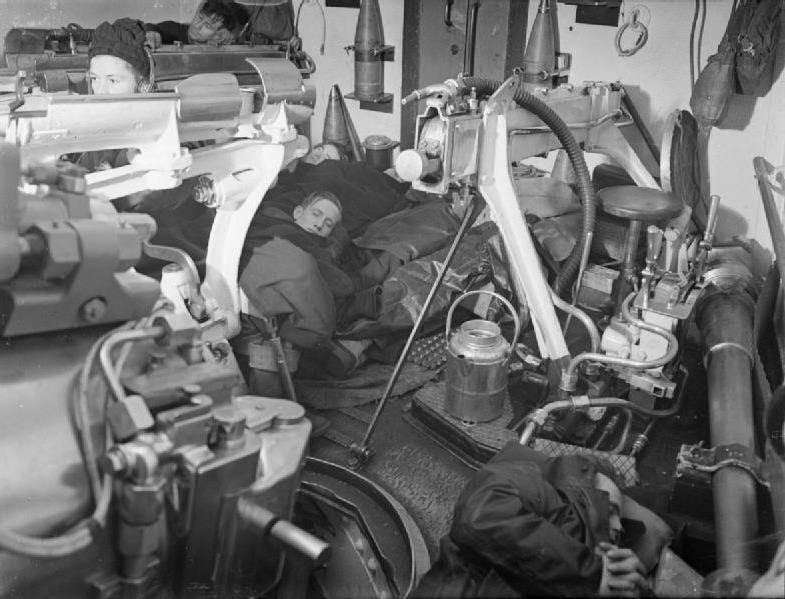
"British Battleships 1919 - 1945: New Revised Edition" by R.A. Burt
"British Naval Gun Mountings: From 1890: 18-inch to 4.5-inch Mark 8" by Ian Buxton
"Naval Weapons of World War Two" and "British Naval Guns 1880-1945 No 13" article in "Warship Volume VIII" both by John Campbell
"Battleship Nelson: The Story of HMS Nelson" by Ronald Careless
"British Battleships of World War Two" by Alan Raven and John Roberts
"The Final Action: The Sinking of Bismarck, 27 May 1941" article by John Roberts in "Warship Volume VII"
07 January 2007 - Benchmark
11 February 2012 - Updated to latest template
03 June 2012 - Added mounting notes and comments by Capt. Binney
05 January 2014 - Added photographs of turrets on HMS Rodney
29 August 2014 - Added photograph of projectile and propellant container
07 August 2019 - Converted to HTML 5 format, reorganized notes, corrected typographical error
19 November 2021 - Minor formatting changes
11 March 2025 - Added mounting information
